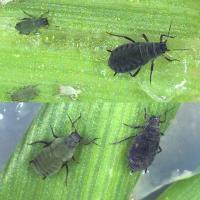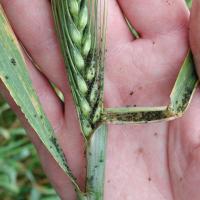Diagnosing cereal aphids
Occasional pests of wheat crops — adult and nymph aphids suck sap with large populations limiting grain yield and size, especially winter and spring infestations. Cereal aphids also spread barley yellow dwarf virus that reduces cereal yield. The two main species are corn aphid and oat aphid.
What to look for
- Corn aphids are dark blue-green to grey-green.
- Oat aphids are the most abundant species of cereal aphids and vary from mottled yellow-green through olive-green and dusky brown, to a blackish green, and are characterised by a reddish patch on the tip of the abdomen.
Insect Adult
- Patches of plants with furled leaves and may have a 'sooty' appearance.
- Corn aphid colonies are often difficult to detect because they usually develop within the furled leaves of tillers any time from seedling to head emergence.
- Oat aphid colonies develop on the outside of tillers from the base upwards on stems, nodes and backs of mature leaves, starting any time between seedling stage and grain filling.
- Feeding damage often has no obvious signs or symptoms, although heavily-infested plants may be covered in black sooty moulds, which live on the sugary honeydew excreted by aphids.
- The degree of damage depends on the growth stage of the crop, percentage of tillers infested, aphids per tiller, and the duration of the infestation.
- Plants may also show signs of barley yellow dwarf virus (BYDV).
Plant
What else could it be
| Condition | Similarities | Differences |
|---|---|---|
| Diagnosing spring drought in wheat and barley | Plants with furled new growth | The main difference is aphid damage tends to be worse in patches and the aphid numbers present reflects the damage done |
| Diagnosing Russian wheat aphid | The aphid was recently detected in Australia for the first time (in South Australia) but has not yet been detected in Western Australia. Please report suspect aphids | Russian wheat aphids do not have the visible protrusions at the base of the body that common cereal aphids have |
Where did it come from?
- Aphids reproduce rapidly during warm, dry weather and can be found on volunteer grasses and cereals in summer/early autumn.
Management strategies

Seed dressing insecticide

Spraying insecticide

Beneficial insects
- BYDV transmission can occur with low numbers of aphids and it is important to protect crops in high-risk areas during the first 12 weeks of growth, or to early stem elongation.
- BYDV is readily controlled by using insecticide seed dressings and/or synthetic pyrethroid foliar sprays at 3 and 7 weeks after cereal crop emergence.
- For direct feeding damage monitor aphid numbers at several sites to gain true representation of population size and avoid unnecessary spraying.
- Spraying is worthwhile in crops expected to yield more than 3 tonnes per hectare and in which 50% of tillers have 10-20 or more aphids.
- Parasitic wasps, ladybeetles, lacewings and hoverflies can provide useful biological control, mainly by preventing secondary outbreaks — use ‘soft’ insecticides that only control aphids to encourage biological control.
Economic and financial considerations
To assist in assessing the economic risk and financial costs associated with various treatment strategies go to MyEconomicTool.
There may be other economic and financial implications that need to be considered when choosing a management option. These may include:
Pre-crop- Understand the potential yield losses associated with aphid feeding damage and possible transmission of the barley yellow dwarf virus (BYDV).
- Assess the costs and benefits of taking preventative action.
- Assess the cost and benefits of controlling ‘green bridge’ (self sown cereals and grass weeds).
- Compare the costs, benefits and risk of each management option against doing nothing
- Consider risk and associated costs or savings of no treatment or delaying treatment until threshold level of aphids is reached.
- Consider the potential risk of re-infection and costs of further treatment.
- Ignore all previous treatment costs in assessing current management options.
- Undertake a ‘what if’ scenario analysis to see what impact changing variables (e.g. grain price and seasonal conditions) have on the profits.
- Consider using an integrated pest management system including a resistance management strategy to reduce the chance of aphids and other non-target insects becoming resistant.
View these economic considerations in more detail.
How can it be monitored?
- Check crops from late tillering onwards for feeding damage by corn aphids in the furled growing tips, and for wheat and oat aphids on stems, backs of leaves and ears.
See also
Page last updated: Friday, 3 February 2017 - 9:36am





